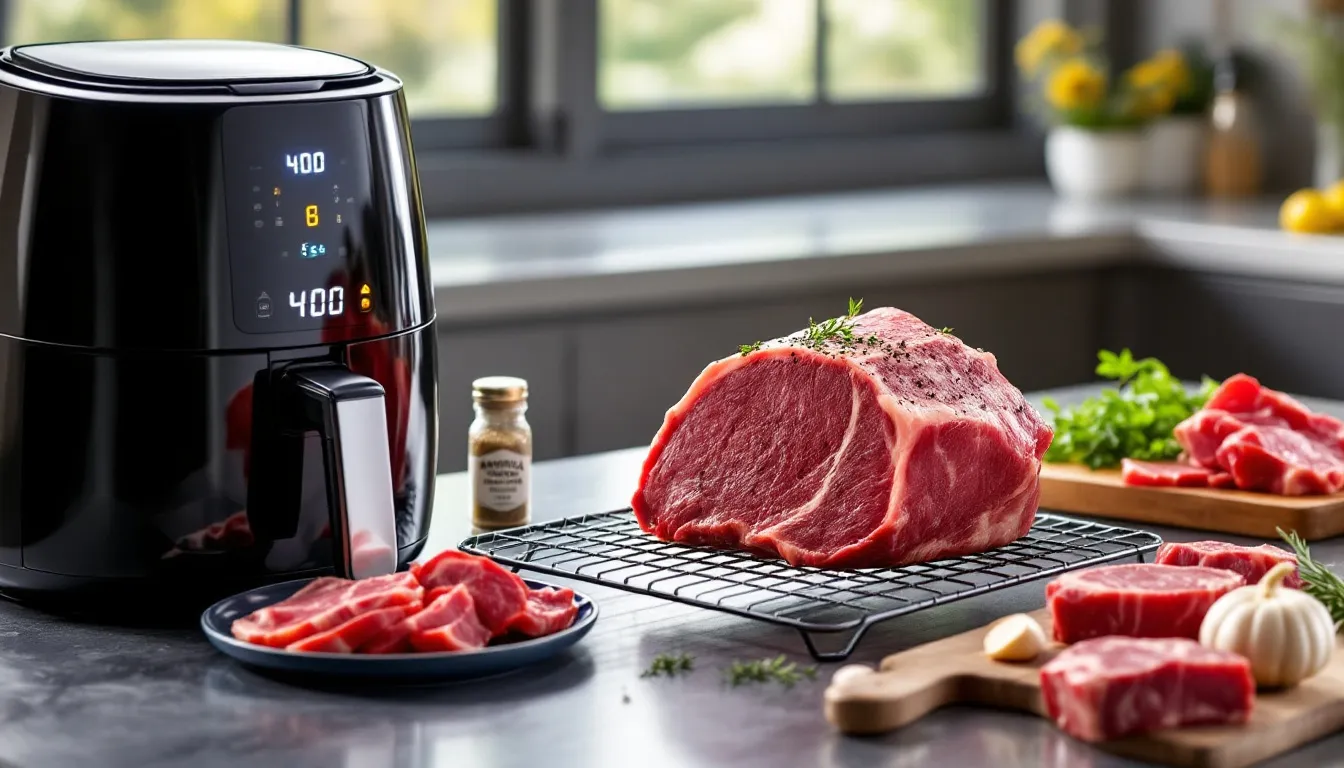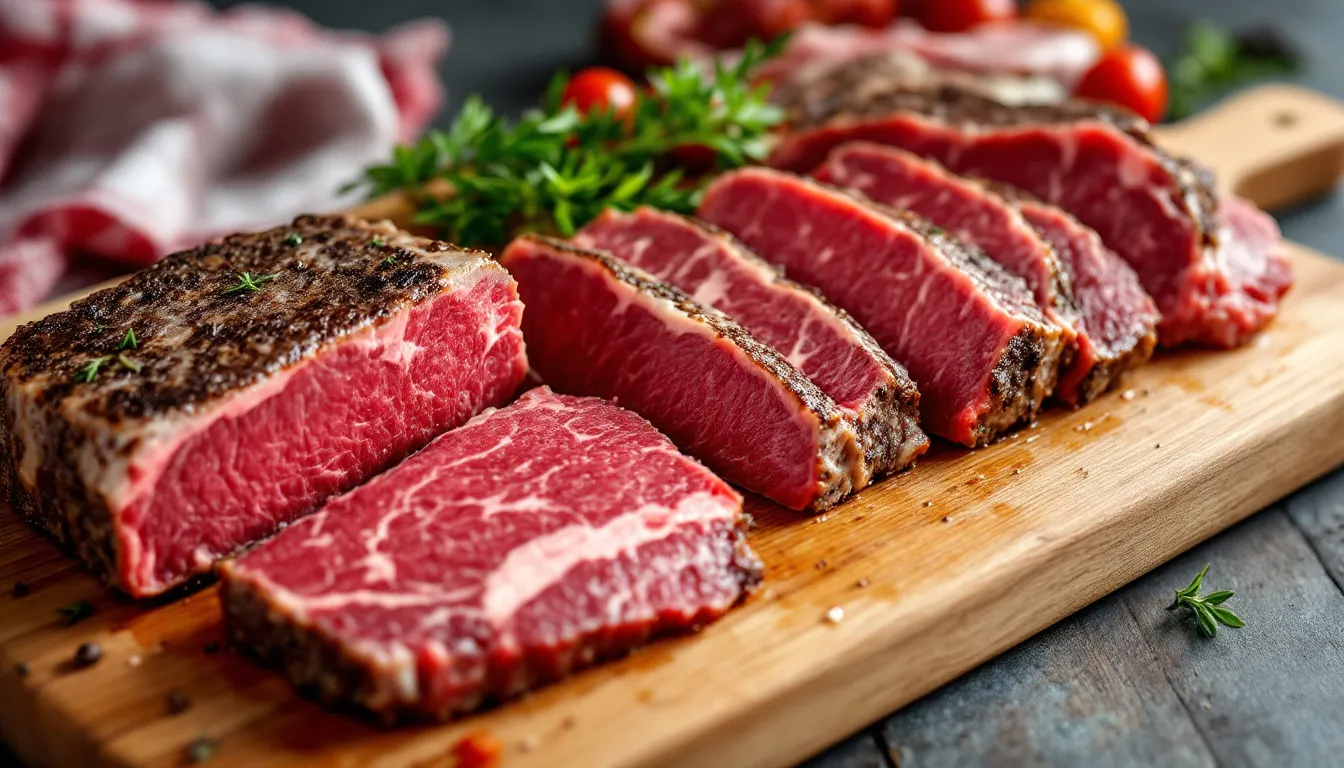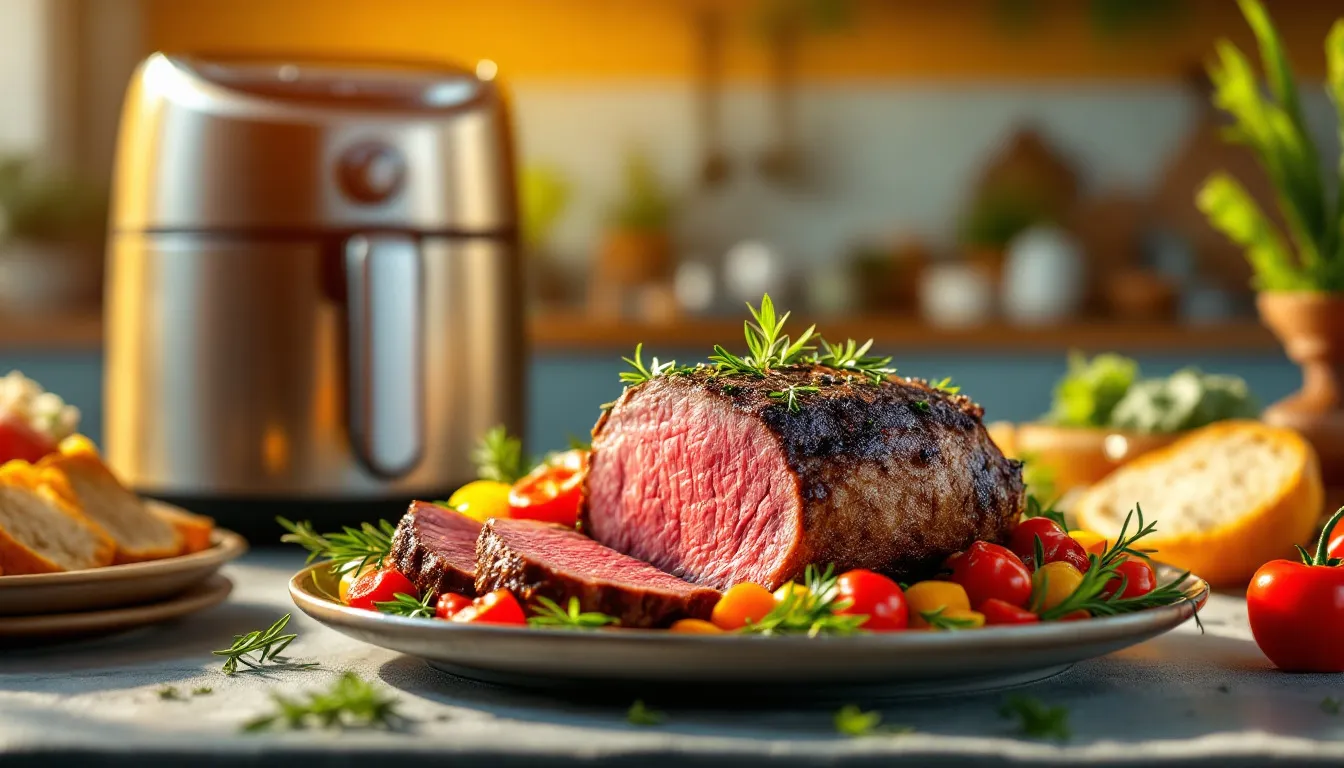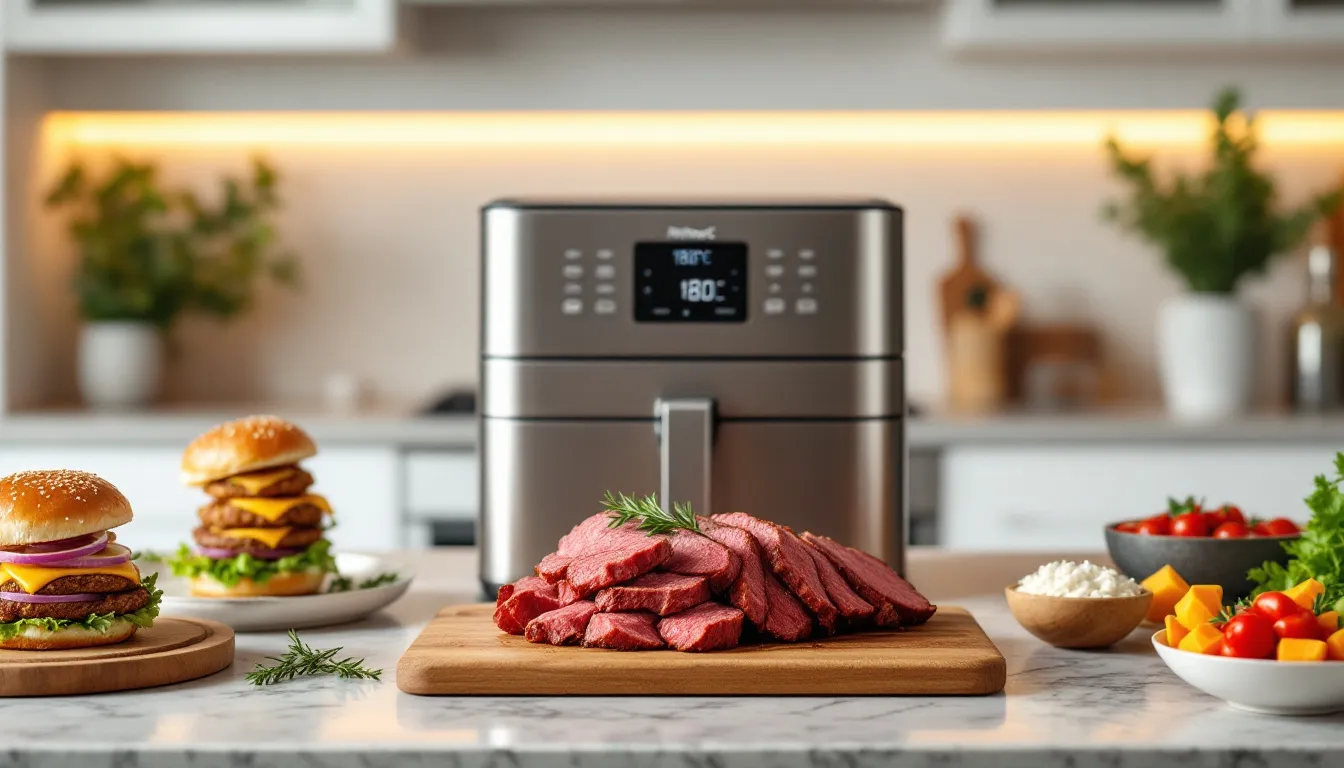Want to cook Roast Beef in Air Fryer? This guide explains how to select, prepare, and cook your beef for a perfect, juicy roast every time. Learn the steps, tips, and essential details you need to know.
Looking for some grass fed, sustainably farmed roast beef? Check out our Sirloin Roast, Chuck Roast, Bottom Round Roast, and Prime Rib Roast.
Key Takeaways
-
Choose the right cut of beef like top round or ribeye, and season well with olive oil and your favorite spices for a juicy roast.
-
Preheat your air fryer to 400°F before cooking and ensure you use a meat thermometer to achieve your desired doneness.
-
Let the roast rest wrapped in foil after cooking for 5-10 minutes to keep it tender and juicy, then slice against the grain for best results.
Ingredients for Air Fryer Roast Beef

Begin with a beef roast weighing between 2 to 3 pounds for the best outcome. Olive oil is ideal for its flavor and crust-forming properties. Basic seasonings like salt and pepper are also necessary.
You can get creative with seasonings—garlic, smoked paprika, and fresh rosemary can elevate your roast. For added depth, try garlic powder, onion powder, or a sprig of fresh rosemary. A well-seasoned roast ensures a flavorful and tender result.
Ensure all ingredients are prepped before starting. The right combination will make your air fryer roast beef easy to cook and irresistibly delicious.
Best Cuts of Beef for Air Frying

Select cuts like top round, sirloin, and ribeye roast for tender, flavorful beef suited to air frying, including round roast and sirloin roast. The KC Strip also performs well in air fryers.
Opt for USDA prime or choice grade beef for better marbling, such as sirloin roast or round roast, ensuring moist and tender meat. Make sure the roast fits comfortably in your air fryer basket and is even in size for consistent air fry cooking. An air fryer beef roast can be a delicious option for your next meal.
Avoid tougher cuts like chuck roast and brisket, as they need longer cooking times to become tender, unsuitable for air frying. Also, avoid large joints that don’t fit well in the air fryer.
Preparing Your Roast Beef
Bring your beef roast to room temperature for at least 30 minutes before cooking to ensure even cooking and prevent the outside from overcooking.
Pat the roast thoroughly dry with paper towels to develop a proper crust during cooking. Season all sides evenly with salt, pepper, and your choice of dried herbs like rosemary, thyme, or basil. Baste with olive oil for added flavor before seasoning.
Experiment with different seasoning mixes such as thyme, onion granules, and mustard powder for a unique twist. Ensure you have all ingredients and tools ready before starting.
Proper preparation sets the foundation for a succulent roast beef and flavorful roast. Though it may seem like an extra step, it makes a significant difference in the final result.
Cooking Time and Temperature
Achieving the perfect time and temperature is key when cooking roast beef in an air fryer to ensure you properly roast in the air. Preheat your air fryer to 400°F (200°C) to ensure an even cook and a nice crust on your roast beef.
After preheating, adjust the air fryer temperature to 360°F (180°C) and place the beef roast inside. Cook for around 40-42 minutes, removing the roast 10 degrees below your desired doneness to reach the perfect internal temperature after resting.
A meat thermometer is essential. Insert it into the thickest part of the beef to check the internal temperature accurately, ensuring your roast beef is cooked to your preferred doneness.
Cooking a Frozen Beef Joint in the Air Fryer
Cooking a frozen beef joint in the air fryer is entirely doable, though it requires a few adjustments to ensure it turns out perfectly cooked. Here’s how you can achieve a succulent roast beef even from frozen:
-
Preheat the Air Fryer: Start by preheating your air fryer to 375°F (190°C). This step is crucial for even cooking.
-
Prepare the Beef: Pat the frozen beef joint dry with paper towels to remove any excess moisture. This helps in forming a nice crust.
-
Season Generously: Season the beef with your favorite herbs and spices. A mix of salt, pepper, garlic powder, and rosemary works wonders.
-
Air Frying: Place the beef in the air fryer basket, ensuring there’s space around it for proper air circulation. Cook the beef for about 20-25 minutes per pound.
-
Check Doneness: Use a meat thermometer to check the internal temperature. For medium-rare, aim for 130-135°F (54-57°C).
-
Resting: Let the beef rest for 10-15 minutes before slicing. This allows the juices to redistribute, ensuring a tender and juicy roast.
While cooking a frozen beef joint might not yield the same tenderness as a fresh one, following these steps will still result in a delicious and perfectly cooked roast beef.
Resting and Slicing Your Roast

Let your roast beef rest after cooking by wrapping it in foil for 5 to 10 minutes. This allows the juices to redistribute, making each bite flavorful and tender.
Skipping the resting period can lead to a less flavorful roast as juices will run out. Ideally, rest the roast for about half the cooking time to ensure optimal juiciness and tenderness.
Slice the tender roast beef thinly against the grain. This technique makes the meat more tender and easier to chew. Proper slicing and adequate resting ensure a perfectly cooked and delicious roast beef.
Serving Suggestions

Serve your air fryer roast beef with a creamy horseradish sauce for a flavorful kick. Side dishes like green beans, roasted carrots, asparagus, or mashed potatoes complement the rich flavors beautifully. Roasted vegetables such as carrots and fennel, rosemary potato wedges, or air-fried Brussels sprouts add a rustic touch and crisp texture to your meal. Try this fryer roast beef recipe for a delicious twist.
Leftover roast beef can be used in salads or sandwiches with horseradish sauce, mayonnaise, and lettuce, or make a delicious roast beef sandwich with various condiments and a fresh bun, making it a versatile dish that can be enjoyed in multiple ways.
Air Fryer Models and Alternatives
Choosing the right air fryer can make a significant difference in your cooking experience. Here are some popular air fryer models and alternatives to consider:
Reheating and Storing Leftovers
Wrap leftover roast beef in foil or store it in an airtight container. Refrigerate for up to 3-4 days. To reheat, preheat your air fryer to 380°F and heat the roast beef for 3-5 minutes with a splash of beef broth to keep it tender.
You can freeze leftovers for up to 3 months, though it’s best to use them within 2 months for optimal flavor. Thaw frozen roast beef on the counter for a few hours before reheating.
Reheat roast beef using appropriate temperatures and methods to avoid drying out the meat. Use leftover roast beef creatively in salads for a protein boost.
Common Mistakes to Avoid
Avoiding common mistakes can significantly improve your air fryer roast beef. Always use a meat thermometer to ensure your roast reaches the desired doneness by inserting it into the thickest part of the beef for an accurate reading.
Not preheating the air fryer can lead to uneven cooking. Ensure it reaches the recommended temperature before placing the roast inside. Overcooking or undercooking is often due to neglecting to check the roast’s doneness with a meat thermometer.
Avoiding these common mistakes ensures your perfectly cooked roast beef is delicious every time.
Summary
Making perfectly cooked roast beef in an air fryer is easier than you might think. By choosing the right cut of beef, preparing it properly, cooking at the correct temperature, and allowing it to rest, you can achieve a tender and flavorful roast every time. We hope this guide has inspired you to try making roast beef in your air fryer. Happy cooking!
Frequently Asked Questions
Can I use a different oil instead of olive oil?
Absolutely, you can swap olive oil for other neutral oils like avocado or vegetable oil without any issues. Just pick one that suits your taste and enjoy your cooking!
How do I know when the roast beef is perfectly cooked?
To know when your roast beef is perfectly cooked, use a meat thermometer and pull it out when it’s 10 degrees below your desired doneness. This way, it’ll reach the perfect temperature as it rests!
What should I do if my roast beef turns out dry?
If your roast beef turns out dry, make sure to let it rest after cooking and use a meat thermometer next time to prevent overcooking. You'll achieve a juicier result!
Can I freeze leftover roast beef?
Absolutely, you can freeze leftover roast beef for up to 3 months, but for the best taste, try to use it within 2 months. Just make sure it's properly wrapped to keep it fresh!
What sides go well with air fryer roast beef?
You can't go wrong with green beans, roasted carrots, or asparagus alongside your air fryer roast beef. Mashed potatoes or rosemary potato wedges will also make for a delicious pairing!

